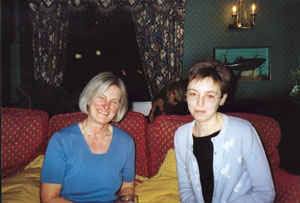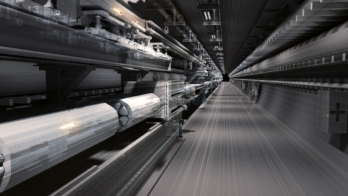The European Committee for Future Accelerators, which met in London in March, was impressed by the vitality of particle physics in the UK.

Continuing its eternal round of visits to CERN member states, the European Committee for Future Accelerators (ECFA) met in London in March, with a side trip to the Rutherford Appleton Laboratory.
The particle physics effort in the UK, with a strong focus on CERN but with many active projects elsewhere, is very dynamic. Despite this success, specialists are not complacent and take care not to be wrong-footed by new developments.
ECFA delegates were happy to hear UK Minister of Science and Space Lord Sainsbury praise the role that their committee has played in coordinating European strategies and in ensuring the coherence of the community.
“Particle physics contributes much more than world-leading science,” he maintained. “European particle physics laboratories are a hot-bed of cutting-edge technology in many other areas. Everyone knows the story of the World Wide Web and has watched, almost in amazement, the explosive growth of the Internet and e-commerce. For example, in the UK, the Web is currently used by more than 34% of the population. This is now having a profound impact on science, commerce and increasingly on our daily lives.”
His main message to particle physicists was to ensure that their new technologies are not only recognized but also transferred for wider industrial and commercial application.
UK funding was described by John Garvey (Birmingham). UK particle physics and astronomy are jointly funded by the Particle Physics and Astronomy Research Council (PPARC) with support through studentships, through direct funding to the university groups – especially research associateships and technical manpower – and through funds for constructing and running experiments. Funding decisions are peer-reviewed by a panel drawn mostly from the university groups, and the projects are administered by the Rutherford Appleton Laboratory (RAL).
Some 16 experimental physics university groups have 166 academic staff, about 200 PhD students (spread over 3-4 years), 190 research associates and fellows, and about 90 technical and computing support staff. The 17 university theory groups have 72 academic staff, more than 100 students and 84 research associates and fellows (including both PPARC- and non-PPARC-funded positions).
RAL has an additional 60 people directly involved in the particle physics programme (which is entirely PPARC funded) and about 100 full-time-equivalent specialists providing technical support.
Experiment programme

Neville Harnew (Oxford) surveyed the UK experimental particle physics programme, with supplementary comments from RAL director Ken Peach, who is the manager of the UK particle physics programme. UK physicists are active in a number of ongoing experiments, both in Europe and the US, and are busy preparing for several future projects. Their major future involvement will be in ATLAS, CMS and ALICE at CERN’s LHC. They are also preparing for LHCb and the Fermilab neutrino experiment MINOS, both of which are close to being approved for PPARC funding.
Activities away from accelerators include the measurement of the neutron electric dipole moment at ILL, Grenoble, the measurement of solar neutrinos at the SNO Sudbury Neutrino Observatory in Canada and searching for dark matter at the Boulby mine, UK.
In addition, some far-sighted UK physicists are busy with R&D for linear colliders and for a neutrino and muon factory. The UK would like to have a neutrino factory at RAL, possibly associated with an upgraded spallation neutron source.
The range of experiments with UK involvement is broad, and enthusiasm and optimism exude everywhere.
Technology and the Central Laboratories
PPARC has a technology panel chaired by Phil Allport (Liverpool), who described UK innovations in instrumentation and the long-term technology plan. A key concept is “data deluge”. Particle physics is driving sensor technologies that have applications across many disciplines, and UK academics, in collaboration with industry, are involved in common programmes.
The GRID project, where UK has taken a leading role, was described by Steve Lloyd (Queen Mary and Westfield College, London), who discussed plans for a UK regional centre for all four major LHC experiments and the resource implications.
The vital role of the Central Laboratories of the Research Councils (CLRC) was reviewed by chief executive designate Gordon Walker. The CLRC, an independent non-departmental public body of the Department of Trade and Industry, comprises the Rutherford Appleton and Daresbury laboratories. These provide science and technology support, operate a number of large facilities for UK users, provide advanced engineering and computing resources, and have their own research programmes.
Facilities include Daresbury’s SRS synchrotron radiation source and the RAL ISIS spallation neutron source. ISIS is the scene of the KARMEN neutrino experiment, with strong German participation, which is looking for evidence of the phenomenon of neutrino oscillations. The new Diamond synchrotron radiation source, with support from France and the Wellcome Foundation, is to be built at RAL.
Peter Sharpe of RAL surveyed advanced resources for microelectronics, where miniaturization is ever smaller. The present microelectronic linewidth of 0.25 mm is expected to decrease five-fold in the next 10 years. RAL and some of the university groups are very much involved in this development, which is expected to be important not only for physics but also in many other fields.
Important decisions are being taken about the future of the CLRC, and ECFA was invited to participate in the debate. In a round-table discussion moderated by ECFA chairman Lorenzo Foà, laboratory directors Luciano Maiani (CERN), Albrecht Wagner (DESY) and Paolo Laurelli (Frascati) explained their view of the role of a national laboratory. PPARC chief executive Ian Halliday examined how its RAL relations might develop.
Richard Kenway (Edinburgh) described the continual evolution of UK particle physics theory and restructuring for the 21st century, partly due to developments in computers and networks. A new proposal involves setting up a national Institute for Particle Physics Phenomenology, and a site decision is imminent.
Anna Burrage, a PhD student working with the H1 collaboration at DESY, alleged that British particle physics PhD students are required to be highly self-motivated and to complete original research at the highest international level.
A supervisory support framework provides academic and technical day-to-day assistance. Students acquire a range of “transferrable skills”, such as computer literacy and communications, which are highly valued by employers.
However, there are problems: students have great difficulty in finishing in three years of funding, and frequently finish their PhD deeper in the red. Burrage pointed out that PPARC is now introducing measures to ensure timely PhD completion, and it will be interesting to see how this develops.
Christine Sutton (Oxford) described PPARC-supported outreach activities in particle physics. These dynamic efforts point the way for similar developments elsewhere. As well as giving information on particle physics in the UK and elsewhere, the Web site also features a memorable “Picture of the Week”.
The ECFA meeting was organized by David Miller from University College, London, and his UK colleagues.





